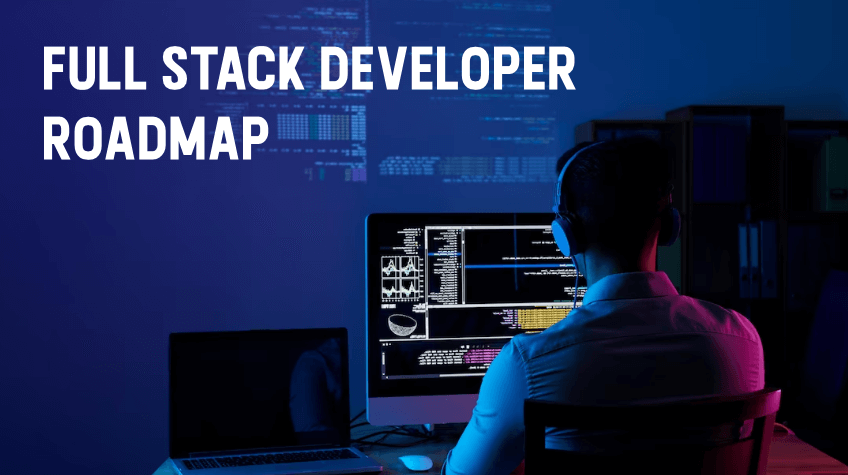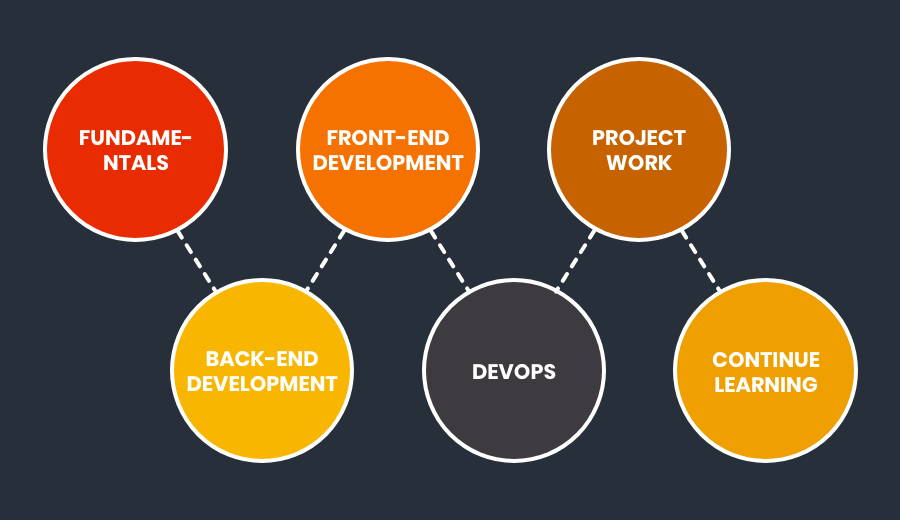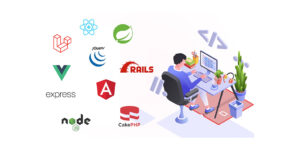
Welcome to a roadmap to become a full-stack developer in 2025! With the rapid evolution of technology and increasing demand for versatile tech professionals, the journey to mastering both front-end and back-end development has never been more exciting. This roadmap will guide you through the essential skills, tools, and techniques required to excel in this in-demand field, empowering you to build dynamic, user-friendly web applications from end to end.
What is full-stack development?
Full-stack development refers to designing and building a web application’s front-end and back-end. Unlike front-end developers who focus on the user-facing aspect of a site and back-end developers who concentrate on server-side functionality, full-stack developers have a comprehensive understanding of the entire web development process.
This includes expertise in HTML, CSS, and JavaScript for front-end development and proficiency in server-side programming languages such as Python, Ruby, and PHP, as well as databases, server management, and API creation. Full-stack development aims to create a seamless and integrated user experience by connecting a website’s front-end and back-end components.
Full-stack developers are in high demand in today’s technology-driven world as businesses seek to create dynamic and user-friendly web applications that deliver a seamless experience across multiple devices. Whether you are a beginner or an experienced developer, becoming a full-stack developer opens up a world of opportunities in the tech industry and beyond.
Time required to learn full-stack development
Becoming a full-stack developer is not a sprint but a marathon. The time required to master full-stack development varies from individual to individual and depends on several factors, such as prior experience, dedication, and the pace of learning.
For a beginner with no prior experience in web development, it may take between 6 months to 2 years to evolve expertise in full-stack development. This time frame involves dedicating a significant amount of time to learning the basics of front-end development, back-end development, and database management.

The learning curve may be shorter for individuals with prior experience in web development. With a solid foundation in front-end or back-end development, it may take six months to 1 year to gain a comprehensive understanding of full-stack development.
Ultimately, the time required to become a full-stack developer depends on your motivation, dedication, and the resources you use to learn. Consistent practice and hands-on projects are key to building the skills and experience necessary to excel in this field.
Recommended courses to learn full-stack development
If you’re interested in learning full-stack development, several excellent courses can help you master both front-end and back-end development. Here are some recommended courses to consider:
1. “The Complete Web Development Bootcamp” by Udemy – This comprehensive course covers everything from the basics of HTML, CSS, and JavaScript to advanced topics like Node.js, Express.js, and MongoDB.
2. “Full-Stack Web Development with React” by Coursera – This course focuses on using React as the front-end framework and Node.js, Express.js, and MongoDB as the back end.
3. “Full-Stack Web Development Specialization” by Coursera – This specialization consists of multiple courses covering front-end and back-end development, database management, and deployment fundamentals.
4. “Full Stack Web Development” by FreeCodeCamp – This self-paced curriculum covers everything from HTML and CSS to Node.js, Express.js, and MongoDB.
5. “Full-Stack Development with MEVN Stack” by Udemy – This course focuses on building full-stack web applications using MongoDB, Express.js, Vue.js, and Node.js (MEVN) stack.
These are just a few excellent courses to assist you in learning full-stack development. Consider your learning style, budget, and the type of projects you want to build when selecting a course to ensure you get the most out of your learning experience.
Full Stack Developer Roadmap 2025
1. Fundamentals
⬥ Begin by knowing the fundamentals of HTML, CSS, and JavaScript. These are the building blocks of web development.
2. Back-End Development
⬥ Get familiar with a server-side framework like Node.js or Python. Familiarize yourself with databases like MySQL, MongoDB and others.
⬥ Get a strong understanding of REST APIs and their communication between the front and back ends.
3. Front-End Development
⬥ Understand a JavaScript framework like React or Angular to build user interfaces.
⬥ Study CSS frameworks such as Bootstrap or Materialize to make styling easier.
4. DevOps
⬥ Learn about tools such as Git, GitHub, Docker, and Kubernetes to manage and deploy your applications.
Also See: What is DevOps and How DevOps Transformation Works in IT
5. Project Work
⬥ Work on personal projects to solidify your skills and build a portfolio to showcase your work.
⬥ Team with different creators on open-source assignments or contribute to existing ones.
6. Continue Learning
⬥ Stay in touch with the most delinquent technologies and advancements in web development.
⬥ Attend workshops, conferences, or online courses to sharpen your skillfulness and learn the latest strategies.
With a solid foundation in the fundamentals, practice, and a commitment to continuous learning, you can become a full-stack developer by 2025.
Additional skills recommended for a full-stack web developer
A Full-stack developer roadmap involves building and maintaining a web application’s front-end and back-end aspects. In addition to the core technical skills such as HTML, CSS, JavaScript, and server-side programming languages like Python, Ruby, or PHP, here are some additional skills that can enhance a full-stack web developer’s expertise:

1. Database management: Familiarity with SQL and NoSQL databases such as MySQL, PostgreSQL, MongoDB, etc., and their management systems are crucial for data storage and retrieval.
2. Version control: Understanding Git and GitHub are essential for collaboration and tracking changes in code.
3. Cloud computing: Knowledge of cloud platforms like Amazon Web Services (AWS), Microsoft Azure, or Google Cloud Platform can help deploy and scale web applications.
4. Responsive design: The ability to create a responsive layout that adapts to different screen sizes is crucial for building user-friendly websites.
5. Security: Awareness of standard web safety threats like SQL injection, cross-site scripting (XSS), and cross-site request forgery (CSRF) and how to prevent them.
6. Performance optimization: Understanding web performance optimization techniques such as caching, minification, and compression to improve a web application’s speed and user experience.
7. Agile methodologies: Acquaintance with Agile methodologies like Scrum and Kanban can help deliver high-quality products efficiently.
8. Problem-solving skills: Strong problem-solving skills and the ability to debug and resolve issues quickly are essential for a full-stack developer.
9. Communication skills: Excellent communication skills and the ability to work in a team is crucial for full-stack development, as it involves collaboration with designers, front-end developers, and back-end developers.
Having these additional skills can make a full-stack web developers well-rounded and equipped to tackle any challenge that comes their way in the dynamic field of web development.
RELATED: 10 Skills Required to Become a Salesforce Developer
FAQs
1. What is full-stack web development?
Full-stack web development involves building and maintaining a web application’s front-end and back-end aspects. It requires expertise in front-end mechanization like HTML, CSS, and JavaScript and back-end mechanization like server-side programming languages and databases.
Building a robust digital foundation goes beyond coding; it requires the expertise of dedicated back-end developers who breathe life into the functionalities that power your applications.
2. What aptitudes are needed to become a full-stack web developer?
The core skills required to become a full-stack web developer include HTML, CSS, JavaScript, and a server-side programming language like Python, Ruby, or PHP. Additionally, skills in database management, version control, cloud computing, responsive design, security, performance optimization, and problem-solving are also necessary.
3. Is it necessary to have a degree to evolve into a full-stack web developer?
No, a degree is not a requirement to evolve into a full-stack web developer. However, having a degree in computer science or a related field can be beneficial in terms of understanding the fundamentals of computer science and gaining exposure to different technologies.
4. What is the most helpful method to comprehend full-stack web development?
The best way to learn full-stack web development is through self-study and hands-on experience. This can be done by pursuing online classes, operating on personal projects, and participating in hackathons or coding questions.
5. What is the duration to evolve a full-stack web developer?
The time it takes to become a full-stack web developer varies from person to person and depends on several factors, such as the amount of time dedicated to learning, previous experience, and natural aptitude for the subject. Generally, gaining the necessary skills and expertise may take six months to 2 years.
6. Are there any certifications available for full-stack web development?
Several certifications are available for full-stack web development, including those offered by tech companies such as Microsoft and Oracle, and industry-recognized certifications like the Certified Full-Stack Developer program.
7. How important is remaining updated with the latest mechanization in full-stack web development?
It is essential to stay up-to-date with the latest technologies in full-stack web development, as the field constantly evolves and new technologies are regularly introduced. Holding up with the most delinquent movements and advances can help a full-stack developer remain competitive and in demand.
In conclusion, A full-stack developer roadmap in 2025 requires combining technical and soft skills to succeed in this constantly evolving field. With the increasing demand for web applications, there has never been a better time to pursue a career in full-stack development.
As technology advances, full-stack developers must stay up-to-date with the latest tools and techniques and continuously improve their skills. The opportunities to learn and grow as a full-stack developer are endless, whether through formal education, online courses, personal projects, or on-the-job experience. Dedication and hard work can make anyone a full-stack web developer and build a successful career in this exciting field. We hope this blog on a roadmap to become a full-stack developer in 2025 is useful to the readers.






